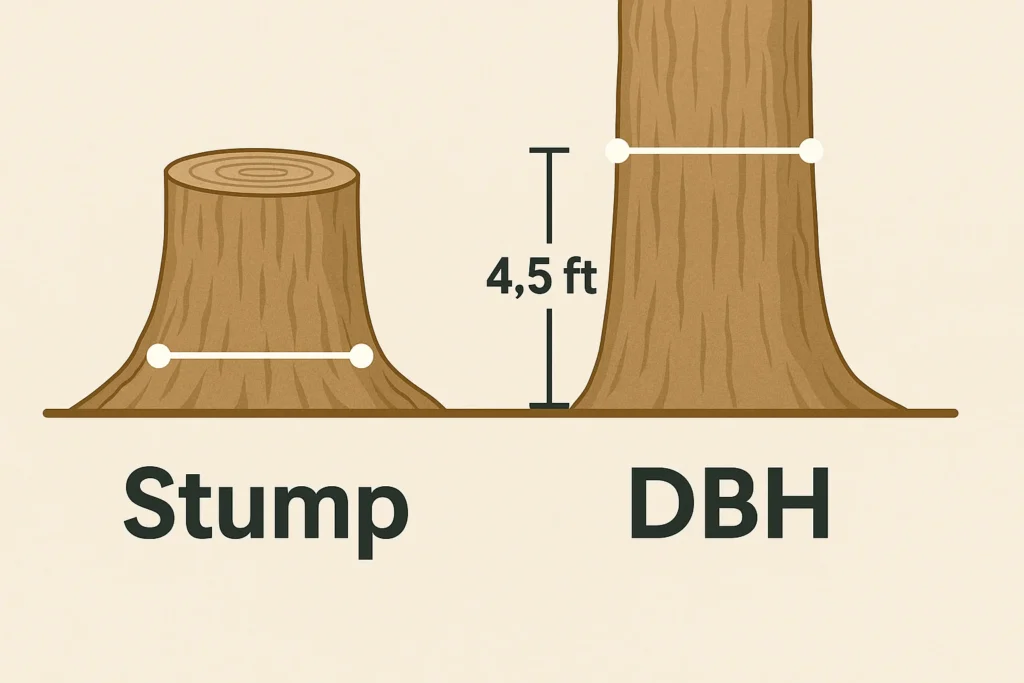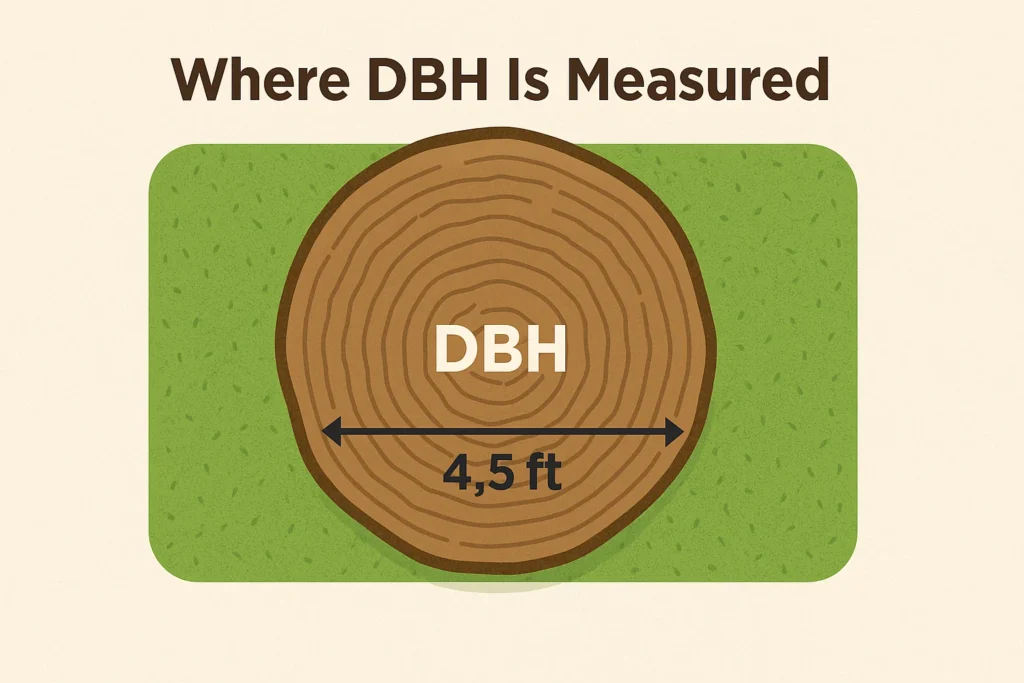🌳 Tree Diameter Calculator
Use this tool to measure and calculate various tree diameters, inside bark diameters, multi-stem DBH, and more. Select the features you need below.
Tree Diameter Calculator: A Complete Guide to Measuring Tree Size Accurately

Created by James S. Lockwood
With a background in botany and ecological sciences, James specializes in creating practical tools and resources to help gardeners, farmers, and plant enthusiasts optimize their green spaces.
Our Tree Diameter Calculator helps you quickly measure a tree’s diameter at breast height (DBH), the industry-standard metric used in forestry and timber valuation. Whether you’re managing woodlots, estimating lumber yield, or assessing tree health, this tool gives you instant diameter measurements from simple tape readings. Just enter the tree’s circumference, and the calculator does the rest—no formulas, no guesswork.

Table of Contents
How to Measure Tree Diameter?
How to calculate diameter of a tree? The most standard way is by using DBH, or Diameter at Breast Height. This is measured 4.5 feet above the ground on the uphill side of the tree. Once you wrap a flexible tape around the trunk and record the circumference in inches, the formula is simple:
DBH = circumference ÷ π (3.1416)
Let’s say you measure 31.4 inches around the trunk. Divide that by 3.1416, and you get exactly 10 inches—your tree’s DBH.
Some people prefer to use a pre-marked diameter tape that does this calculation for you automatically, but even a standard tape measure works just fine if you have a calculator handy.
Still, the easier and faster route is using an online tree diameter calculator, especially when you’re doing this for multiple trees. Just plug in the number, and it does the math instantly.
Tree DBH from Stump Diameter

Now, what if the tree is already cut down? Can you still calculate tree DBH from stump diameter?
Yes—but it comes with a caveat. A stump is usually wider than the trunk at breast height due to the natural flare of roots. So if you measure a stump at, say, 14 inches across, the actual DBH might only be around 10–12 inches.
Use a tree diameter calculator that includes a “stump-to-DBH” conversion. For example:
Stump Diameter (inches) x 0.8 = Estimated DBH
This isn’t an exact science, and the factor can vary by species. Oaks, for instance, flare less than pines. Still, it’s a useful estimation tool—especially if you’re working backward to use a tree age calculator diameter to determine how old the tree was.
You can try this directly using our Tree Age Calculator, which takes DBH as an input and estimates age based on growth factor.
Why DBH Matters?

It’s easy to underestimate the value of a simple measurement, but DBH is crucial for:
Timber valuation: Lumber prices often scale with trunk size.
Tree age estimation: Growth factor tables depend on DBH.
Forest health: Tree growth over time shows forest condition.
Environmental impact: Carbon sequestration is linked to trunk volume.
If you want an official reference on tree diameter measurements, the USDA Forest Service offers measurement guidelines and data sheets. They explain DBH standards for multiple species, tools for accuracy, and how measurements vary by region.
You’ll also find species-specific formulas in university research papers—especially useful if you’re looking to calculate tree DBH from diameter measurements taken in different conditions.
While DBH doesn’t capture everything—some trees with hollow trunks or odd growth forms can skew the data—it remains the single most trusted size metric in forestry.
DBH Estimation Chart
Sometimes, you don’t even need to measure. A rough lookup table can help estimate tree diameter based on trunk circumference. Here’s a basic reference:
To go deeper into the math, use our interactive Tree Height Calculator in tandem with DBH to estimate tree volume or value.
Frequently Asked Questions (FAQs)
1. What is DBH, and why is it important?
DBH (Diameter at Breast Height) is the standard measurement of tree diameter taken at 4.5 feet (1.37 meters) above the ground. It is essential for forestry assessments, timber valuation, and ecological research.
2. Can I measure DBH without a tape measure?
Yes, you can estimate DBH using a caliper, a flexible string (to find circumference), or by referencing known objects of similar size.
3. How do I calculate the inside bark diameter?
The inside bark diameter (IBD) is calculated by subtracting twice the bark thickness from the outside bark diameter. Our calculator does this automatically.
4. How do I measure a tree with multiple stems?
Measure each stem’s diameter individually and use the aggregate DBH formula: Aggregate DBH = √(D₁² + D₂² + D₃² + … Dn²).
5. What if my measurement isn’t taken at breast height?
If you measure the tree at a different height, use species-based correction factors or remeasure at the standard 4.5 feet.
6. How to calculate the diameter of a tree?
Wrap a measuring tape around the trunk at 4.5 feet from the ground, note the circumference, and divide by 3.1416. That gives you the diameter at breast height (DBH).
Or simply use a tree diameter calculator to do the math for you—especially if you’re measuring multiple trees or want stump-to-DBH conversions too.
7. How old is a 10 diameter tree?
It depends on the species. A 10-inch DBH white oak might be around 45 years old, while a fast-growing pine could be closer to 20 years. Use a tree age calculator diameter tool with growth factor settings for more accuracy.
8. How to calculate tree DBH?
DBH is calculated using the formula:
DBH = circumference ÷ π
It’s taken at 4.5 feet above ground level, not at the base or higher up.
9. How do you estimate the size of a tree?
Size can mean diameter, height, or canopy spread. For diameter, use a tree diameter calculator. For height, check out our Tree Height Calculator. Combine both to estimate total size or even potential lumber value using our Tree Value Calculator.
What About Christmas Trees?
While rarely used for timber calculations, even holiday trees have their place. Our tree diameter calculator might help farmers determine trunk strength for safe harvesting. These tend to be smaller (4–6 inches DBH) but still require consistent measurement for market grading.
Final Thoughts
A tree diameter calculator simplifies one of the most important forestry measurements. Whether you’re in the field measuring old-growth timber or just curious about that tree in your backyard, understanding DBH opens the door to deeper insights—into age, value, carbon capture, and more.
The best part? You don’t need fancy tools—just a tape measure, a calculator (or ours), and a little curiosity.
Disclaimer for Tree Diameter Calculator
The Tree Diameter Calculator provides estimated measurements and should be used as a reference tool. Actual values may vary based on tree species, environmental conditions, and measurement accuracy. For official forestry assessments or timber calculations, professional measurement tools and methodologies are recommended.
Discover Tree & Forestry Calculators
